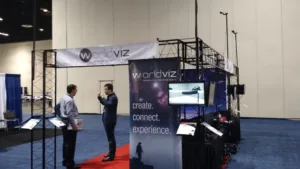Debuted just prior to I/ITSEC at the Autodesk University event in Las Vegas, the company was also demonstrating a content creation tool called ‘Skofield’ at I/ITSEC as well. Skofield is a cloud-based application targeting aerospace, automotive, and architecture, but is designed to be very simple to use. In the demo we had, the company described Skofield as “kind of like PowerPoint for VR or GoToMeeting inside a VR Headset”, meaning it was easy to create 3D objects and animations and add to a VR workspace for collaboration. The idea is to take advantage of VR’s ability to make someone feel “present” in a virtual location.
Skofield has two main elements: creation and experience. Designers can use Skofield’s Presentation Designer software to assemble a VR presentation by dragging and dropping elements into the WYSIWYG editor. Presentation Designer will also allow the presenter to modify the presentation by setting proximity triggers, defining which objects have interactivity, and more. In addition to creating virtual spaces and interactive objects, presenters can also insert PDFs and PPT slides, such as training manuals or product fact sheets, to support a presentation.
After the presentation is created, attendees are invited to join a session. A set of tools will give attendees the ability to interact with the presentation in different ways, for example by moving around the virtual space, zooming in on or interacting with or annotating objects, measuring distances, or even using a virtual laser pointer. Skofield also provides telephony for voice as well as gaze tracking, and can record meetings for later reference.
For the demo, I put on an Vive headset and used two hand controllers and a headphones. I was joined in the virtual meeting by two WorldViz employees who were represented as a very basic ‘head and two hands’.
One of the WorldViz participants led the meeting and first presented the difference between the Oculus Rift and the HTC Vive. For each headset, he used animations in the virtual space to point out the location of the motion sensing devices and their area of coverage (HTC is bigger). Then, he expanded the room to show the warehouse scale of the coverage WorldViz offers with their optical trackers. This was followed by an animation that showed an airplane next to us, then, a bank of servers. This customer used the VR space to climb a virtual ladder to be sure they could service a component on top of the server racks.
Finally, these images were replaced by two flat screen which represented short throw projection solutions. These showed flat images, but I was then instructed to pick up a pair of 3D glasses and the images became 3D. That was quite cool.
After this presentation, I was told that all of these animations were initiated by the hand controller, with the assets assembled using Skofield. Skofield is being built on WorldViz’s existing device-agnostic development software, Vizard. It will support a number of different VR hardware configurations using Vizard’s built-in feature, VizConnect. Initially Oculus Rift and HTC Vive will be supported, as well as the current 3D displays, CAVE projection systems, input devices, and mobile devices WorldViz already supports. Other headsets will be added over time depending on demand.
Skofield will be distributed as a cloud-based solution, but can also be set up on a company’s existing servers for highly sensitive environments. Pricing for Skofield will be announced at a later date. – CC

